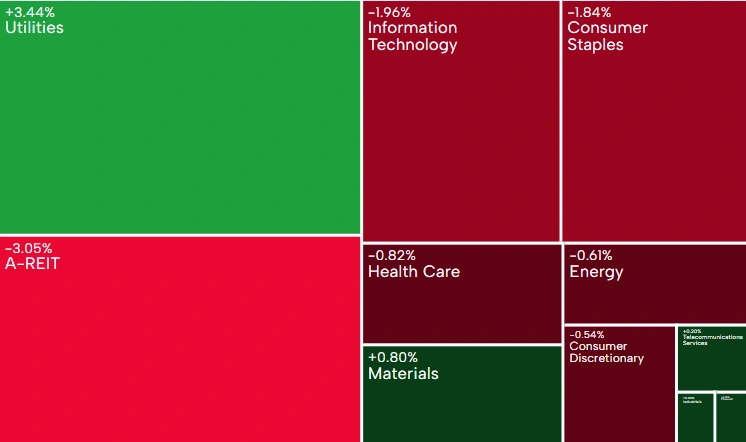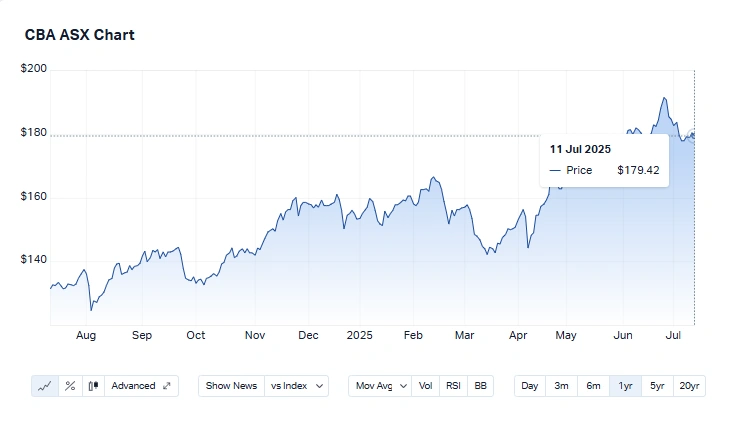The Australian share market closed lower with tariffs tensions once again emerging globally. The ASX 200 slipped by 0.1% to 8,580.1 points. Then, the All Ordinaries fell to 8,816.7.
A fresh tariff announcement by U.S. President Donald Trump sowed doubts among investors. Hence, despite a strong mining sector, the markets witnessed selling pressure in other sectors.
![]()
ASX slips amid global tariff fears, tracking declines across major sectors and heightened investor caution.
What triggered the market drop this week?
Trump had said tariffs would vary between 15 to 20 per cent for most trade partners. Canada saw the highest tariff, up to 35 per cent. Australia, though, was not directly targeted; hence, it felt the secondary effects.
Markets across Asia and Europe turned risk-averse. Concerns over supply chains, inflation, and export restrictions weighed on Australian equities.
Which sectors held their ground?
Utilities and Materials came to the rescue. Utilities managed to gain 3.44% for the week, despite an intraday dip of 0.23%.
Materials drew strength from a two-month peak in iron ore prices, rising 0.80%. Telecommunications Services stayed fairly flat with gains of around 0.04%.
Mining giants performed exceedingly well:
- BHP shot up 2.77% to $39.36
- Fortescue Metals gained 2.85% to $16.98
- Rio Tinto rose 2.28% to $111.10
Such gains surely cushioned the blow for much of the broader market decline.
How badly did other sectors fare?
Sector-wise performance over the last five trading days remained on the negative terrain, with six of the eleven major sectors making losses. A-REITs led the losses, dropping 3.05% amidst increased interest rate concerns. Information Technology slipped 1.96%, and Consumer Staples fell 1.84% owing to waning consumer sentiment.
Health Care saw a 0.82% decline amid reduced risk appetite, while Energy dropped by 0.61% as commodity prices steadied. Consumer Discretionary slightly moved downwards by 0.54%, suggesting cautious attitudes toward discretionary spending.
Overall, the data indicates some rotation toward defensive positioning, as investors began to shy away from growth-sensitive sectors in the wake of growing global uncertainty.

Utilities lead ASX sectors; A-REITs and Tech post steepest losses.
What happened to banks and the Aussie dollar?
The bank stocks came under slight selling pressure amid growing cautiousness. Commonwealth Bank fell 0.53% to $179.42 while NAB and Westpac also recorded small declines.
ANZ was somewhat of an outlier, gaining marginally by 0.13%, possibly reflecting relatively stronger balance sheet strength. Despite this mixed performance, the overall sentiment for the banking sector lacked strength on account of concerns associated with tariffs and rising global rates.
The Aussie, meanwhile, weakened to 65.83 US cents, driven by the strengthening greenback. A low Aussie dollar usually helps exporters as it tends to make the goods less expensive for foreign buyers, but raises the cost price of imports and adversely impacts the buying power of domestic consumers.

Commonwealth Bank of Australia (CBA) Market Share
Should investors adjust their portfolios now?
Certainly, divergences at a sectoral level make the case for selective investing. In times of volatility, Utilities and Materials tend to emerge as safer bets. On the other hand, sectors affected by changes in interest rates and consumption-like A-REITs and IT continue struggling to exist. Given such a setting, a portfolio tilt toward income-yielding and commodity-driven stocks appears to be timely.
Investor outlook: cautious optimism or renewed risk?
Bearing that in mind, investors must keep an eye on bond yields and global inflation data. The broader landscape seems balanced presently. Australia might, eventually, stand to gain from realignments in global trade routes. The Productivity Commission estimates a 0.37% GDP uplift from redirection of investment, which supports the view of capital inflow in the longer term.
Three potential tailwinds are:
- Strong demand for Australian iron ore
- Outperformance in Utilities and Materials
- Exporters aided by a weak Australian dollar
Three downside risks are:
- Heightened trade war volatility
- Interest rate concerns are pressuring real estate
- Weakness in tech and consumer spending
Over the short term, the ASX 200 may consolidate near 8,600. Inflation data and US earnings due next week will be watched closely.
Also Read: Johns Lyng Group Takeover: Share Price Soars After $1.3 Billion Deal
Summary
Although the ASX 200 traded down to 8,580.1 amid resurgent tariff concerns that troubled global markets, tariffs of up to 35% had been priced into investor sentiments, worth a hit, particularly on the trade-sensitive and cyclical sectors. The strong upside in Mining, Utilities, and Materials offered the sustenance to broader losses. Still, six out of the eleven major sectors entered their negative zone by close of the week, with A-REITs taking the biggest hit of 3.05%. Bank stocks followed suit due to cautious positioning, while the Aussie dollar fell to 65.83 US cents against a stronger greenback. Investors are currently turning their attention to more defensive and income-generating assets as volatility heightens.












